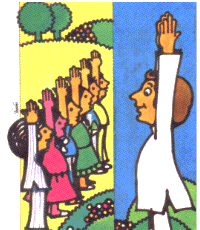In 1985, eminent educationist, Professor Krishna Kumar spent some time at the Children’s Literature Centre, Tikamgarh, Madhya Pradesh, interacting with children. In the course of his stay, he tried out several activities with the children, keeping in mind a child-centred perspective.
Among other things it laid stress on a wider use of language — not merely as “a means of communication but as a means to think, feel and react to things.”
It was especially important for teachers working with young children — and parents and caretakers – to understand the role language played in giving the child a sense of the world around her, he stressed.
In 1986, Prof. Kumar’s activity handbook was published under the aegis of UNICEF, and has been of immense value to primary school teachers across the country. We reproduce excerpts from the chapter “What do we mean by language?”
Language and Doing
Children’s use of language is closely related to the things they do with their hands and bodies and the objects they come in contact with. Words and action go together in childhood. Action and experiences create the need for words, and words provide access to an experience after it is over. With the help of words, children enrich their relationship with the objects they come in touch with.
On the other hand, words without action or contact with objects remain empty and lifeless for the child. Words like ‘cat’, ‘run’, ‘fall’, blur’, ‘river’ and ‘rough’ mean very little to the child unless these words have first been used in a context where the child was actively involved with the object or in an act. Only after such involvement do these words become associated with an image, and become available for meaningful use in future.
This relationship between words and the child’s physical experiences poses a unique responsibility on adults, especially teachers. As a teacher you may expect that parents have already provided a wide range of experiences to the children who are now under your care.
This may not be true for the great majority of parents. Many parents either do not feel confident enough to allow their children to come in contact with a wide range of objects in early childhood or they do not have the time to accommodate the much slower pace at which children see and do things.
Often, adults find it a nuisance if the child stands at the tap with her fingers in the stream of water for half an hour, or if she puts all the utensils on the floor, or if she wants to open and close an umbrella countless times. Sometimes, in order to avoid any possibility of damage to objects or harm to the child, adults prohibit the child from all but a narrow range of experience.
Whatever the parents may or may not have done, the job of the teacher is fairly clear. She must create an environment, which permits children to make continuous attempts to link the use of language with life’s experiences and objects. This can be done by ensuring:
- that children bring to school a variety of objects (such as leaves, stones, feathers, twigs, broken things) and talk about them, read about them and write about them.
- that children are asked to talk, write and read about the experiences they have had outside the school.

The Language of a Child [Published by the National Book Trust, India]
- that children are taken out of the classroom to see the world around the school so they can inspect ordinary objects carefully (objects such as a broken bridge, a muddy pit, a dead insect, a nest with eggs) and talk about them. Such study-visits in the school’s immediate neighbourhood can provide valuable resources for language-learning as this handbook will later show.
- So, a school where children are not doing a variety of things with their hands, where they are mostly sitting and listening to the teacher, and where there are no objects to touch, manipulate, break and remake, cannot be a good place to develop language skills.
Things they do with language
Those who have studied children’s language tell us that children start using language for a startling variety of purposes as soon as they have acquired mastery over basic abilities involved in talking. What follows is a discussion of some of the purposes.
1) Directing one’s own activities: Children often talk about what they are doing at the time they are doing it. It is a kind of private commentary on their own action. Often, it seems the commentary helps them in carrying on with the activity for a greater length of time. It helps them maintain their interest in it. It does not matter if someone listens to the commentary.
For example, in a group of small children making tunnels or castles with damp sand, each child may make a separate commentary and often it may be no more than an audible mumble.
2) Directing other’s activities and attention: This use of language is well known to us as parents and teachers since a lot of our time is spent meeting children’s demands. We are usually quite conscious of demands that are of a physical nature, but other kinds of demands are also significant.
These other kinds of demands can be intellectual or of an emotional nature. Children use language to draw attention to something that they find curious or attractive. They expect the listener to show interest in what has attracted their own attention.
If you observe children in a group, you will often find them drawing each other’s attention by pointing out something or a characteristic of something they think others might have missed. The importance of this use of language lies in the expectation it expresses.
The expectation is that ‘others would like to see what I have noticed’. This expectation is based on a deep-seated assumption concerning human relationships and the pleasure of being together. If the person whose attention is being directed does not fulfil the expectation, a basic cause for the development of language gets discouraged.
3) To play: For most children from the age of two and a half onwards, words serve as a great resource for play and fun. They repeat words in different tones, distort them, combine them in strange combinations, and enjoy this whole process. They like to use words in situations where they may not be appropriate. They easily learn poems that distort words in this way. In brief, young children treat words as objects to play with. Play with words serves as an enormous outlet for creativity and energy.
Listen to the rhymes that children sing while playing by themselves or in groups, indoors or on the street, skipping, running, jumping, ball-bouncing. If you are observant and careful, you may be able to make a small collection of traditional children’s rhymes of your area that are still alive — despite the invasion of modern media and inert language teaching.
Write out the rhymes you find in a systematic manner. Look for variations and record them. Do not correct what appear to you as examples of bad grammar or distortions of vocabulary. Children’s play-rhymes are a rare resource of highly creative and energetic forms of language. And they are extremely useful means of developing certain basic language skills, such as reading. See the next chapter for suggestions on how to use them.
Following are examples of traditional children’s rhymes…
‘I am a gold lock’.
‘I am a gold key’.
‘I am a silver lock’.
‘I am a silver key’.
‘I am a brass lock’.
‘I am a brass key’.
‘I am a monk lock’.
‘I am a monkey’.
No school today, half holiday.
When we get our holiday we’ll all run away.
Where will we run to? Down the slippy lane.
Who will run after us? The teacher with the cane.
4) Explaining things: Children talk about things to show their knowledge of how a thing happened. For example, if you ask a child of three how it rained, the child will probably tell you that the sky was covered with grey clouds, then little drops began to fall, and then it rained hard, so hard that you couldn’t see anything.
In this example, by narrating the sequence of events, the child is explaining how a major event occurred, stories are born out of this use of language, and in this sense, all stories are explanations of things. Of course, not all stories provide reliable or scientific explanations of things; what they represent is our desire to interpret life. Small children want to interpret their life’s events just as much as we adults want to explain events that have occurred in the world or in politics.
5) Representing life: This use of language is present in all other uses, but we need to study it separately or else we might overlook it. Children, just like adults, often use language to recall the past – to remember an event, person, or just a small thing. Words help us re-create something that is no more around, and often what has been re-created looks so real that we can go on talking about it for a long time.
Children often represent things and experiences in order to come to terms with them — to accept something at a deep emotional level. A child who has been frightened by something may talk about it many times over – until he adjusts to it. Especially when life springs a surprise on the child, he overcomes the surprise (with its uncertainty, confusion and sometimes fear) by repeatedly re-creating the incident with the help of words until the incident becomes a familiar one.
6) Associating: When we listen to a story that someone is telling, about his own experience or someone else’s, we respond to the story by associating ourselves with the characters and events described in the story. We project ourselves beyond our immediate life, even beyond our restricted past experiences, in order to relate to the story. When a child talks about the feelings of a metal toy, he imagines himself to be the toy. Language allows us to experience vicariously what someone else is going through.
7) Anticipating: Things that have not yet occurred, and some of which may not occur at all form a subject of talk all the time. Children express their fears, plans, expectations and what they think might happen under strange circumstances, frequently. Words allow them to create an image of the future frequently. Sometimes such an image helps in materialising the future; at other times it helps in accepting the future as it comes.
8) Inquiring and reasoning: Just about any situation can present a ‘problem’ that the small child must solve by finding out ‘why’ something is the way it is.
Many problems are of the kind that the small child can successfully solve; for example, why a bus stopped all of a sudden, or why she does not like water to be poured on her head while she has her bath. The little child of three understands these ‘problems’ although not all children may be able to explain the precise reason in a vocal manner.
Some children who can do so are most likely the ones who have heard adults using language to inquire or argue about something and who have been encouraged to do so themselves.
Unlike the ‘problems’ mentioned above, there are others that a small child cannot grasp in a ‘scientific’ sense. For example, the real reason ‘why it rains’ or ‘why a tree falls down when the wind is very strong’ is beyond the reach of a child of four or five. Yet, even such problems present excellent opportunities for the use of language as a means to reason.
It does not matter whether the reason given is accurate or not. What is important is that the child uses language as a means to reason, to inquire about something unknown. The more frequently the child listens to adults using language for this function, the more likely is this function of language to become accessible to the child.
What we say affects us.
One thing we learn about language is its various functions in children’s lives is that it is a highly flexible medium. It can be adjusted to almost any situation in life. By adjusting it according to the needs of a situation, we improve our adjustment with the situation itself.
Daily life provides numerous examples of this process. When we know that someone is angry with us, we respond to his anger by choosing (often unconsciously) words and tone that might shape the situation according to our wish or intention. For example, we use strong words if we want to fight, or we use mild words and tone if we want to cool down the situation.
We can say that our ability to use language in a flexible manner to a great extent determines our chance of standing up to the great variety of situations that life presents.
At one level, our language expresses or shows our response to a situation; at another level, our language shapes the situation that we are facing. Language helps us to come to terms with things that happen around us all the time. It helps us in this way whether we are physically participating in events or simply reflecting on them.
Whether we witness an event physically or not, the language used to re-present it affects our response to it. Thousands of things happen everyday at places far away from us. These things reach us as narratives in a newspaper. In a sense, the newspaper allows us to create a picture of an event.
It is the same thing when a child tells his mother about something he has seen on the street. The picture created by the newspaper or the child is accurate in as much as the language used for the narration is accurate. Accuracy is almost always a matter of degree because any use of language reflects the narrator’s intention.
If the child has seen an accident and was frightened by it, he is likely to convey it in a somewhat exaggerated manner. By exaggerating it, he justifies his fear, and thereby feels better adjusted to the sight he had seen.
Finally, language shapes our expectations. Someone who likes to explain things in patient, systematic manner expects others to do the same. Similarly, a person who likes to inquire deeply about things unconsciously expects that others are also interested in such inquiry. By using language to explain or inquire, such people create an environment in which the importance of explanation and inquiry is understood.
On the other hand, if language is not used for such purposes in a community or in institutions, the children growing up there are unlikely to be used to careful explanations or patient arguments. If parents and teachers are using language mainly to keep children under control, then it is likely that children will see language as a means to control others. They might grow up into adults who do not want to do anything unless they are ordered to do so.
…language shapes the child’s personality because the child lives and grows up in the environment that language creates. To this environment, the teacher makes a significant contribution. If her responses show that the teacher understands the child’s aim in using language in a certain way, such responses show that the teacher understands the child’s aim in using language in a certain way, such responses will enhance the child’s use of language in that mode.
On the contrary, if the teacher’s responses are based on preconceived ideas about what is appropriate or correct, such responses will obstruct the child’s independence of expression and communication.










